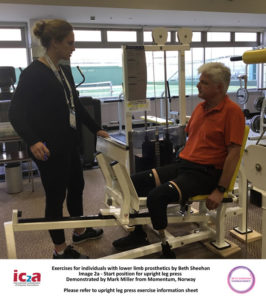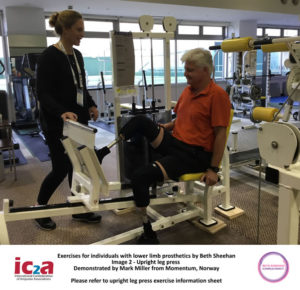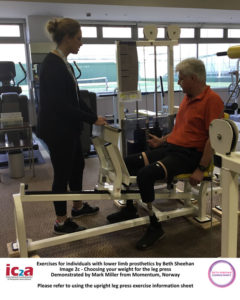Using the upright leg press
Note: These exercises were part of a demonstration session led by expert accredited exercise physiologist Beth Sheehan for IC2A and are intended for general guidance. Individuals should always consult their health or exercise professional to ensure these exercises are appropriate for their own use.
Demonstrated by Mark Miller, Momentum, Norway.
Please refer to image 2a – start position for upright leg press, 2b – on the upright press and 2c choosing the weight for the leg press.


Choosing your weight for the leg press:

• Start light to get the movement happening first.
• Ensure you can sustain your feet in a neutral or hip width position during the movement before you add extra weight (this may require a footrest or straps).
• You need to ensure you can push the foot plate out and lock it out (using the hand lever) to be able to take your legs off the plate at the end of the exercise. If not, you will require assistance and will need to maintain light weights until you develop strength.
Using the upright leg press:
• Double below knee amputee (DBKA).
• Depending how flexible your hips are and the strength in your legs you may need assistance to get into the machine.
• Start with the foot plate far away so that you can lift your legs into a straight position. Ideally you would use a machine that has footrests on the foot plate or straps as amputees often find it hard to anchor their feet on a ‘free’ platform.
• Slowly bring the plate towards you as you take the weight through your legs.
• Only bring the plate as close to your body as you can sustain the weight as well as what your flexibility will allow.
• Once you are in a bent knee position imagine pushing through your heels and push out to a position where your legs are almost straight (slight bend in your knees).
• Control the movement back in.
• This exercise works front (quads) and back (hamstrings) of thighs as well as your bottom (glute) muscles.
• Ensure you can sustain your feet hip width apart and if not seek a footrest or straps to assist.
Return to exercises for individuals with lower limb prosthetics
